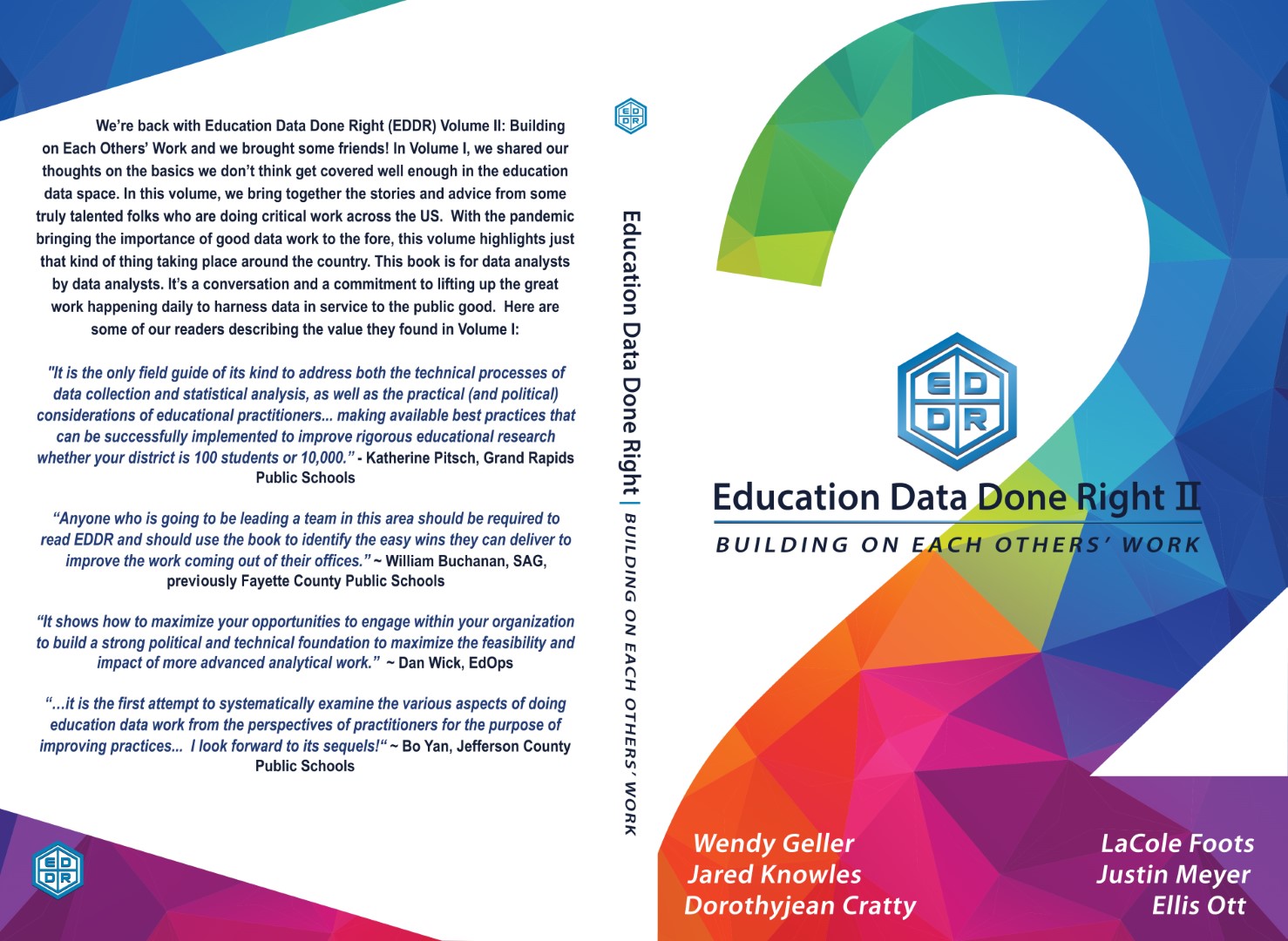Volume 2: Building on Each Others’ Work

Table of Contents
Six data analysts with expertise in public education agencies across the country have teamed up to write a new volume for the Education Data Done Right (EDDR) series.
Following the success of the first volume in this series, which covered missing elements critical to success in building data capacity in education agencies, this new volume showcases applied data science strategies and lessons learned in agencies across the country. New chapters explain how to document work to ensure continuity of operations, navigate data governance, and ensure transparency and reproducibility of agencies’ important work; how early warning systems can be useful in agencies’ work; and why self-awareness of how identities shape the work is one of the most important skills data analysts must have.
Written by Dorothyjean Cratty, LaCole Foots, Wendy Geller, Jared Knowles, Justin Meyer, and Ellis Ott, this new volume covers education data science strategies and lessons with a perspective only possible from authors who’ve been in the trenches and gotten the work done. The series is intended for education agency data analysts, and data managers, strategists, and leaders seeking to improve how their agency operates. Many education agency data analysts come from a social science research background and the transition to work inside agencies can come with a lot of new challenges. This series is a guide through those challenges.
Praise for Volume 1
Buy the book!
You can now get a printed copy of the book on Amazon. Just $15.
The ebook is always available in multiple formats, DRM-free, for “pay what you can” with a suggested price of $15.
“It is the only field guide of its kind to address both the technical processes of data collection and statistical analysis, as well as the practical (and political) considerations of educational practitioners… making available best practices that can be successfully implemented to improve rigorous educational research whether your district is 100 students or 10,000.” ~ Katherine Pitsch, Grand Rapids Public Schools
“Anyone who is going to be leading a team in this area should be required to read EDDR and should use the book to identify easy wins they can deliver to improve the work coming out of their offices.” ~ William Buchanan, SAG Corporation, previously Fayette County Public Schools (FCPS) in Kentucky
“It shows how to maximize your opportunities to engage within your organization to build a strong political and technical foundation to maxmiize the feasibility and impact of more advanced analytical work.” ~ Dan Wick, EdOps
“… it is the first attempt to systematically examine the various aspects of doing education data work from the perspecteives of practitioners for the purpose of improving practices … I look forward to its sequels!” ~ Bo Yan, Jefferson County Public Schools, Kentucky

About EDDR
Across the country hundreds of data scientists and analysts are working for thousands of education agencies trying to help schools, school leaders, and education systems as a whole function more effectively. The work they do is critical to everything from scheduling classes and evaluating programs, to managing enrollments, strategic planning, and making the laws that shape our public education infrastructure at large.
This book is for them. For their work.
Lots of pundits and researchers have ideas about how education data work should be done and who should do it. Many of their ideas are disseminated widely. But, there are far fewer places for education analysts themselves to share their ideas, to describe their challenges, or to cover their efforts to do good science in the everyday.
We wanted to bring the voices and the work these folks do to the forefront, so others among them could learn from the hard fought advances they’ve made and that benefit us all.
This book is by folks who’ve been agency analysts for folks who are agency analysts.
And we hope it is just the beginning.
Welcome
You. Yes, you there. Isn’t it exciting? You are sitting down at your desk at your new job as an education data analyst. You’ve been trained in so many statistical methods, you’re a wizard with R or Stata, you can adjust standard errors with the best of them – you’ve got this. Plus, now that you are working at an education agency you don’t have to sift through a tedious IRB and data request process – you can get started right away doing powerful analyses that will improve the decision making of your agency.
As you turn on the computer and drink your coffee, you are filled with anticipation. You’ve already requested all of the longitudinal assessment data from IT so you can get a jump start. You open your email, eager to download the data and get started, but instead you see:
“About that request for data – we’ll need you to be part of a data governance discussion with us. The attached data includes a number of shifting definitions and cannot be used for year to year comparisons at this time.”
Data what? Definitions? The field names are all the same, so what’s the problem here? You take a deep breath and Google “Education data governance” and now, you’re here.
Welcome.
We’ve all been there.
Let’s talk about what comes next.